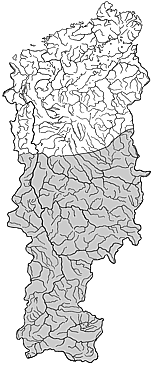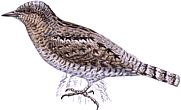|
|
| Main |
| Systematic List |
| Photo |
| Central Siberia |
| Guest book |
| Awards |
| SEARCH |
|---|
|
|
Picidae |
|---|
Wryneck Jynx torquilla Linnaeus, 1758
|
 According to Tugarinov and Buturlin (1911), the Wryneck appears further north along the Yenisey than in other pans of Eurasia, i.e., to Nizhne-Imbatskoye at 64° N in typical northern taiga. We traced the species even further north along the Yenisey to Angutikha, 66°10' N in extreme northern taiga (Rogacheva and Vakhrushev 1983); in Evenkia, A.A. Vakhrushev located the Wryneck near 64°30' N (Vakhrushev and Vakhrusheva 1987). The main habitats the species occupies are sparse forests or areas with individual large trees usually near bums, forest openings, meadows, or other open areas. It also inhabits parks, gardens, and anthropogenic landscapes in general, nesting on occasion even in buildings. In the north of Central Siberia, it occurs mainly in forests along large rivers and near bums and clear-cuts. According to rather controversial data, the Wryneck is most numerous in forest-steppe and the southern part of subtaiga. E.A. Krutovskaya reported the species as a rare bird in the cultivated landscapes near the Stolby Reserve (Krutovskaya 1958), and in 1978, it was recorded in subtaiga in the Poyma River basin (Ravkin et al. 1988). It is rare throughout the taiga zone, although in places it can be common in some years. In the Yenisey mid taiga subzone, it generally inhabits clear forests and dry forest openings, but it is rare everywhere. It arrives in Mimoye between May 14 and 21 and migrants are caught in Helgoland traps until June 10. The species bred and occurred quite regularly in the years 1981-1984. At other times, it occurred only sporadically and almost exclusively during the migration periods. The breeding sites it utilizes are tree stumps, windfalls, and tree hollows on bums and in sparse forests on slopes with forest openings and abundant ant hills. Two to three pairs were found breeding close together in such areas near the Verkhnyaya Sarchikha River at the mouth of the Kamenny stream in 1982. On the totally burned site near the bank of the Varlamovka River 30 km upstream from the mouth, several pairs were found breeding 200 m apart between June 10 and 14, 1983. On June 18, 1984, a Wryneck occupied a hollow in an old willow on the natural levee along the Yenisey opposite Mimoye, and in 1981 a pair nested directly in the settlement. On June 9, it was seen moving about the settlement and the adjacent forest opening extensively, and mating calls and mating activity could also be observed. Then on June 17, it occupied a nesting box from which a Starling brood had fledged 4 days before. On July 7, the nestlings could be heard peeping for the first time. On July 24, a fledgling was found nearby and several more were seen the following day; but on July 26, several nestlings still remained in the nesting box. Autumn migration occurs late in August; the latest record for the season fell on September 10. |
[Back] |
|
|
|
|
Сайт разработан и поддерживается кафедрой прикладной экологии и ресурсоведения СФУ
